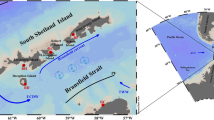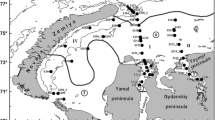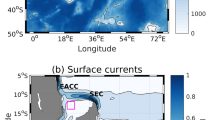Abstract
Bio-physical glider measurements from a unique process-oriented experiment in the Eastern Alboran Sea (AlborEx) allowed us to observe the distribution of the deep chlorophyll maximum (DCM) across an intense density front, with a resolution (∼ 400 m) suitable for investigating sub-mesoscale dynamics. This front, at the interface between Atlantic and Mediterranean waters, had a sharp density gradient (Δρ ∼ 1 kg/m3 in ∼ 10 km) and showed imprints of (sub-)mesoscale phenomena on tracer distributions. Specifically, the chlorophyll-a concentration within the DCM showed a disrupted pattern along isopycnal surfaces, with patches bearing a relationship to the stratification (buoyancy frequency) at depths between 30 and 60 m. In order to estimate the primary production (PP) rate within the chlorophyll patches observed at the sub-surface, we applied the Morel and Andrè (J Geophys Res 96:685–698 1991) bio-optical model using the photosynthetic active radiation (PAR) from Argo profiles collected simultaneously with glider data. The highest production was located concurrently with domed isopycnals on the fresh side of the front, suggestive that (sub-)mesoscale upwelling is carrying phytoplankton patches from less to more illuminated levels, with a contemporaneous delivering of nutrients. Integrated estimations of PP (1.3 g C m−2d−1) along the glider path are two to four times larger than the estimations obtained from satellite-based algorithms, i.e., derived from the 8-day composite fields extracted over the glider trip path. Despite the differences in spatial and temporal sampling between instruments, the differences in PP estimations are mainly due to the inability of the satellite to measure DCM patches responsible for the high production. The deepest (depth > 60 m) chlorophyll patches are almost unproductive and probably transported passively (subducted) from upper productive layers. Finally, the relationship between primary production and oxygen is also investigated. The logarithm of the primary production in the DCM interior (chlorophyll (Chl) > 0.5 mg/m3) shows a linear negative relationship with the apparent oxygen utilization, confirming that high chlorophyll patches are productive. The slope of this relationship is different for Atlantic, mixed interface waters and Mediterranean waters, suggesting the presence of differences in planktonic communities (whether physiological, population, or community level should be object of further investigation) on the different sides of the front. In addition, the ratio of optical backscatter to Chl is high within the intermediate (mixed) waters, which is suggestive of large phytoplankton cells, and lower within the core of the Atlantic and Mediterranean waters. These observations highlight the relevance of fronts in triggering primary production at DCM level and shaping the characteristic patchiness of the pelagic domain. This gains further relevance considering the inadequacy of optical satellite sensors to observe DCM concentrations at such fine scales.









Similar content being viewed by others
References
Antoine D, Andrè J, Morel A (1996) Oceanic primary production : Ii. estimation at global scale from satellite (coastal zone color scanner) chlorophyll. Glob Biogeochem Cycles 10:57–69
Behrenfeld MJ (2010) Abandoning Sverdrup’s critical depth hypothesis on phytoplankton blooms. Ecol 91:977–989
Behrenfeld MJ, Falkowski PG (1997) Photosynthetic rates derived from satellite-based chlorophyll concentration. Limnol Oceanogr 42(1):1–20
de Boyer Montégut C, Madec G, Fischer AS, Lazar A, Iudicone D (2004) Mixed layer depth over the global ocean: an examination of profile data and a profile-based climatology. J Geophys Res Oceans 109 (C12):n/a–n/a. doi:10.1029/2004JC002378, c12003
Cetinić I, Perry MJ, D’Asaro E, Briggs N, Poulton N, Sieracki ME, Lee CM (2015) A simple optical index shows spatial and temporal heterogeneity in phytoplankton community composition during the 2008 North Atlantic Bloom Experiment. Biogeosciences 12(7):2179–2194. doi:10.5194/bg-12-2179-2015, http://www.biogeosciences.net/12/2179/2015/
Chiswell SM (2011) Annual cycles and spring blooms in phytoplankton: don’t abandon sverdrup completely. Mar Ecol Prog Ser 443:39–50
Chiswell SM, Calil PH, Boyd PW (2015) Spring blooms and annual cycles of phytoplankton: a unified perspective. Journal of Plankton Research. doi:10.1093/plankt/fbv021, http://plankt.oxfordjournals.org/content/early/2015/04/08/plankt.fbv021.abstract, http://plankt.oxfordjournals.org/content/early/2015/04/08/plankt.fbv021.full.pdf+html
Cullen J (1982) The deep chlorophyll maximum: comparing vertical profiles of chlorophyll a. Can J Fish Aquat Sci 39(5):791–803. https://www.scopus.com/inward/record.uri?eid=2-s2.0-0020369517&partnerID=40&md5=48cddb15fba9964e0cb50004cb0d8e37, cited By 442
Delgado M, Latasa M, Estrada M (1992) Variability in the size-fractionated distribution of the phytoplankton across the catalan front of the north-west mediterranean. J Plankton Res 14(5):753–771. doi:10.1093/plankt/14.5.753, https://www.scopus.com/inward/record.uri?eid=2-s2.0-0027038493&partnerID=40&md5=672ea91e91812dd41e89e51c6242c325, cited By 41
Estrada M (1996) Primary production in the northwestern Mediterranean. Sci Mar 60(Suppl.2):55–64
Franks PJS (2014) Has Sverdrup’s critical depth hypothesis been tested? Mixed layers vs. turbulent layers. ICES Journal of Marine Science: Journal du Conseil. doi:10.1093/icesjms/fsu175, http://icesjms.oxfordjournals.org/content/early/2014/10/17/icesjms.fsu175.abstract, http://icesjms.oxfordjournals.org/content/early/2014/10/17/icesjms.fsu175.full.pdf+html
Garau B, Ruiz S, Zhang WG, Pascual A, Heslop E, Kerfoot J, Tintoré J (2011) Thermal lag correction on Slocum CTD glider data. J Atmos Ocean Technol 28(9):1065–1071
Hemsley VS, Smyth TJ, Martin AP, Frajka-Williams E, Thompson AF, Damerell G, Painter SC (2015) Estimating oceanic primary production using vertical irradiance and chlorophyll profiles from ocean gliders in the North Atlantic. Environ Sci Technol 49(19):11,612–11,621. doi:10.1021/acs.est.5b00608, pMID: 26301371
Hodges B, Rudnick D (2004) Simple models of steady deep maxima in chlorophyll and biomass. Deep-Sea Res I(51):999–1015
Holm-Hansen O, Lorenzen C, Holmes R, Strickland J (1965) Fluorometric determination of chlorophyll. J Cons Perm Int Explor Mar Sci Commun 30:3–15
Huisman J, van Oostveen P, Weissing F (1999) Critical depth and critical turbulence: two different mechanisms for the development of phytoplankton blooms. Limnol Oceanogr 44(7):1781–1787
Lazzara L, Bricaud A, Claustre H (1996) Spectral absorption and fluorescence excitation properties of phytoplanktonic populations at a mesotrophic and an oligotrophic site in the tropical north atlantic (eumeli program). Deep-Sea Res I Oceanogr Res Pap 43(8):1215–1240. doi:10.1016/0967-0637(96)00057-X, http://www.sciencedirect.com/science/article/pii/096706379600057X
Lefevre D, Minas H, Minas M, Robinson C, Williams PLB, Woodward E (1997) Review of gross community production, primary production, net community production and dark community respiration in the gulf of lions. Deep-Sea Res II Top Stud Oceanogr 44(3):801–832. doi:10.1016/S0967-0645(96)00091-4, http://www.sciencedirect.com/science/article/pii/S0967064596000914
Lévy M (2008) The modulation of biological production by oceanic mesoscale turbulence. In: Weiss J, Provenzale A (eds) Transport and mixing in geophysical flows, lecture notes in physics, vol 744, springer berlin/heidelberg, pp 219–261
Lévy M, Ferrari R, Franks PJS, Martin AP, Rivière P (2012) Bringing physics to life at the submesoscale. Geophys Res Lett 39(14):L14602. doi:10.1029/2012GL052756
Mahadevan A (2016) The impact of submesoscale physics on primary productivity of plankton. Annu Rev Mar Sci 8(1):161–184. doi:10.1146/annurev-marine-010814-015912, pMID: 26394203
Mahadevan A, Tandon A (2006) An analysis of mechanisms for submesoscale vertical motion at ocean fronts. Ocean Model 14(3-4):241–256
Mahadevan A, D’Asaro E, Lee C, Perry M (2012) Eddy-driven stratification initiates North Atlantic spring phytoplankton blooms. Science 336(6090):54–58
McGillicuddy JDJ (2016) Mechanisms of physical-biological-biogeochemical interaction at the oceanic mesoscale. Annu Rev Mar Sci 8:125–159. doi:10.1146/annurev-marine-010814-015606, https://www.scopus.com/inward/record.uri?eid=2-s2.0-84954231340&partnerID=40&md5=bdf3294183e54575b27558a8b9cef9ef cited By 5
Mignot A, Claustre H, Uitz J, Poteau A, D’Ortenzio F, Xing X (2014) Understanding the seasonal dynamics of phytoplankton biomass and the deep chlorophyll maximum in oligotrophic environments: a bio-argo float investigation. Glob Biogeochem Cycles 28(8):856–876. doi:10.1002/2013GB004781, 2013GB004781
Moran XAG, Taupier-Letage I, Vazquez-Dominguez E, Ruiz S, Arin L, Raimbault P, Estrada M (2001) Physical-biological coupling in the Algerian basin (sw mediterranean) : influence of mesoscale instabilities on the biomass and production of phytoplankton and bacterioplankton. Deep-Sea Res I(48):405–437
Morel A, Andrè JM (1991) Pigment distribution and primary production in the western Mediterranean as derived and modeled from coastal zone color scanner observations. J Geophys Res 96:685–698
Mousing EA, Richardson K, Bendtsen J, Cetini I, Perry MJ (2016) Evidence of small-scale spatial structuring of phytoplankton alpha- and beta-diversity in the open ocean. Journal of Ecology pp n/a–n/a. doi:10.1111/1365-2745.12634
Navarro G, Ruiz J (2013) Hysteresis conditions the vertical position of deep chlorophyll maximum in the temperate ocean. Glob Biogeochem Cycles 27(4):1013–1022. doi:10.1002/gbc.20093, 2012GB004396
Oguz T, Macías D, Tintoré J (2014) Impacts of boundary current instabilities on plankton production characteristics of the catalano-balearic sea (western Mediterranean). Ocean Modelling submitted manuscript
Pascual A, Ruiz S, Olita A, Troupin C, Claret M, Casas B, Mourre B, Poulain PM, Tovar-Sanchez A, Capet A, Mason E, Allen J, Mahadevan AJT (2017) A multiplatform experiment to unravel meso- and submesoscale processes in an intense front (alborex). Front Mar Sci 4:39. doi:10.3389/fmars.2017.00039
Platt T (1986) Primary production of the ocean water column as a function of surface light intensity: algorithms for remote sensing. Deep-Sea Res I Oceanogr Res Pap 33:149–163. doi:10.1016/0198-0149(86)90115-9
Platt T, Caverhill C, Sathyendranath S (1991) Basin-scale estimates of oceanic primary production by remote sensing: the North Atlantic. J Geophys Res 96(C8):15,147–15,159. https://www.scopus.com/inward/record.uri?eid=2-s2.0-0026268345&partnerID=40&md5=bfa4f4537db70e6471fa686025861627, cited By 145
Poulain PM, Barbanti R, Font J, Cruzado A, Millot C, Gertman I, Griffa A, Molcard A, Rupolo V, Le Bras S, Petit de la Villeon L (2007) Medargo: a drifting profiler program in the mediterranean sea. Ocean Sci 3(3):379–395. doi:10.5194/os-3-379-2007, http://www.ocean-sci.net/3/379/2007/
Raimbault P, Coste B, Boulhadid M, Benyahia B (1993) Origin of high phytoplankton concentration in deep chlorophyll maximum (dcm) in a frontal region of southwestern Mediterranean Sea (Algerian current). Deep-Sea Res I(49):791–804
Rodríguez J, Blanco JM, Jiménez-Gómez F, Echevarría F, Gil J, Rodríguez V, Ruiz J, Bautista B, Guerrero F (1998) Patterns in the size structure of the phytoplankton community in the deep fluorescence maximum of the Alboran Sea (southwestern mediterranean). Deep-Sea Res I Oceanogr Res Pap 45(10):1577–1593. doi:10.1016/S0967-0637(98)00030-2, http://www.sciencedirect.com/science/article/pii/S0967063798000302
Ruiz S, Pascual A, Casas B, Poulain P, Olita A, Troupin C, Torner M, Allen J, Tovar-Sánchez A, Mourre B, Massanet A, Palmer M, Margirier F, Balaguer P, Castilla C, Claret C, Mahadevan A, Tintoré (2015) Report on operation and data analysis from multi-platform synoptic intensive experiment (alborex). Tech. rep., D3.8 Policy-oriented marine Environmental Research in the Southern European Seas
Ruiz S, Claret M, Pascual A, Olita A, Troupin C, Capet A, Tovar-Sanchez A, Allen J, Poulain PM, Tintoré J, Mahadevan A (2017) Effects of oceanic meso- and submeso-scale frontal processes 1 on the vertical transport of phytoplankton. Nature Communications, submitted
Siswanto E, Ishizaka J, Yokouchi K (2005) Estimating chlorophyll-a vertical profiles from satellite data and the implication for primary production in the Kuroshio front of the east China sea. J Oceanogr 61(3):575–589. doi:10.1007/s10872-005-0066-7
Soetaert K, Petzoldt T (2010) Inverse modelling, sensitivity and monte carlo analysis in r using package fme. J Stat Softw 33(3):1–28. https://www.scopus.com/inward/record.uri?eid=2-s2.0-77953156810&partnerID=40&md5=a81a3c884f59de1454e0ffda979fc02a, cited By 97
Sverdrup H (1953) On conditions for the vernal blooming of phytoplankton. J Cons Int Explor Mer 18:287–295
Taylor JR, Ferrari R (2011a) Ocean fronts trigger high latitude phytoplankton blooms. Geophys Res Lett 38:L23601. doi:10.1029/2011GL049312
Taylor JR, Ferrari R (2011b) Shutdown of turbulent convection as a new criterion for the onset of spring phytoplankton blooms. Limnol Oceanogr 56(6):2293–2307. doi:10.4319/lo.2011.56.6.2293
Tintoré J, La Violette P, Blade I, Cruzado A (1988) A study of an intense density front in the eastern alboran sea: the Almeria–Oran front. J Phys Oceanogr 18(10):1384–1397
Varela R, Cruzado A, Tintoré J, Garcia Ladona E (1992) Modelling the deep-chlorophyll maximum: a coupled physical- biological approach. J Mar Res 50(3):441–463. https://www.scopus.com/inward/record.uri?eid=2-s2.0-0027010940&partnerID=40&md5=1bf725c26b38a5d441d1b785febbf296, cited By 51
Videau C, Sournia A, Prieur L, Fiala M (1994) Phytoplankton and primary production characteristics at selected sites in the geostrophic Almeria-Oran front system (sw mediterranean sea). J Mar Syst 5(3):235–250. doi:10.1016/0924-7963(94)90049-3, http://www.sciencedirect.com/science/article/pii/0924796394900493
Zielinski O, Oschlies OLA, Reuter R (2002) Underwater light field and its effect on a one-dimensional ecosystem model at station estoc, north of the canary islands. Deep-Sea Res II Top Stud Oceanogr 49(17):3529–3542. doi:10.1016/S0967-0645(02)00096-6, http://www.sciencedirect.com/science/article/pii/S0967064502000966
Acknowledgments
This work has been partly funded by the Jerico-TNA program, under the project named FRIPP (FRontal Dynamics Influencing Primary Production), and by the Italian Flagship Project RITMARE. AlborEx experiment was financed by the Perseus project and funded by the EU under FP7 Theme “Oceans of Tomorrow” OCEAN.2011-3 Grant Agreement No. 287600. Arthur Capet is a FNRS researcher under the FNRS BENTHOX project (Convention T.1009.15).
Authors would also like to thank Dr. Stefania Sparnocchia for her precious support as responsible for the JERICO-TNA program, Dr. Marc Toner Tomàs who has efficiently piloted the gliders, Dr. Charles Troupin for providing relevant technical information, Dr. Victoria Hemsley for her precious suggestions about PP algorithm, and Dr. David Roque by helping in bottle data processing.
Author information
Authors and Affiliations
Corresponding author
Additional information
Responsible Editor: Alexander Barth
This article is part of the Topical Collection on the 48th International Liège Colloquium on Ocean Dynamics, Liège, Belgium, 23-27 May 2016
Appendix
Appendix
1.1 A Calibration of the optical model
The pragmatic objective of this section is to calibrate, on the basis of the Prov-Bio optical data (Section 2.2), an optical model suited to reconstruct the PAR conditions along the AlborEx coastal glider (SG) transect. For this specific objective, only the profiles obtained between the 26st of May and the 7th of June were considered, when the Prov-Bio path was close to the AlborEx front.
Several candidate optical models were tested, considering a single bandwidth with Chl and CDOM attenuation (PAR1) or two bandwiths (Zielinski et al. 2002) with attenuation from Chl only (PAR2) or Chl and CDOM (PAR3):
For the sake of simplicity and since all profiles were taken at the same hour of the day in a 12-day interval, the incoming surface radiation was considered to be identical for all profiles and was tuned as a single parameter. Only two profiles were excluded for the calibration (corresponding respectively to the 1st and 5th of June) as they presented obviously affected incoming surface radiation, for instance due to cloud cover (Fig. 10).
The parameters of models PAR1, PAR2, and PAR3 were calibrated to reproduce at best the corresponding Prov-Bio PAR profiles, when applied on the concurrent Chl and CDOM data. The skill associated with each model is given as the root of the PAR mean squared residuals evaluated for all the selected profiles (i.e., 11 profiles consisting of ∼ 215 measurement each) and are provided in Table 2.
The consideration of two band widths in models PAR2 and PAR3 enhances the model skills. The consideration of CDOM in PAR3 does not appear beneficial in what regards the model skill and poses an additional question in terms of parameter identifiability.
We finally retained model PAR2, with parameters PAR0 = 1532 μE m−2 s−1; p s = 0.806; k s,sw = 5.295 10−2m−1; k l,sw = 3.189 10−6m−1; k s,Chl = 3.328 10−2m2 mg Chl−1; k l,Chl = 7.23m2 mg Chl−1;
The probability distribution around those values, as well as the dependencies between different parameter estimates, are depicted on Fig. 11 showing the distribution of parameter values retained in a Monte Carlo Markov Chain procedure (Soetaert and Petzoldt 2010). The pairwise relationships between successful parameter sets indicate a strong correlation between the long-wave band attenuation coefficients for seawater (k l,sw) and Chl (k l,Chl). In other terms, the good matching between simulated and observed PAR profiles is somewhat equivalent whether the long-wave band is attenuated by seawater or Chl. We retained the best parameter values indicated above, which gives a large weight to Chl for the long-wave attenuation, but we checked carefully that the PP estimates obtained from SG data were only marginally affected when using a parameter set in which long-band attenuation was driven by seawater.
Marginal parameter distributions (diagonal), pairwise relationship (upper panels), and correlation coefficients (lower panels) between parameters of the optical model PAR2, obtained by applying a Markov Chain Monte Carlo procedure as described in (Soetaert and Petzoldt 2010). Note the strong relationship between the calibrated seawater and chlorophyll attenuation coefficient, in particular for the long-wave light band
The PAR2 model provides a representation of the PAR profiles suitable for the next steps of this study (Fig. 12, with percentage residuals always below 50% and usually well below 25% in the upper 60 m, a depth below which PAR is always lower than 5% of the surface incoming radiation).
PAR profiles reproduced by applying the PAR2 function on Prov-Bio profiles. First and second rows present (wide light line) modeled and (thin dark line) observed PAR profiles on different scales. Third and fourth rows present the corresponding residuals. The fifth row indicates the relative residuals, i.e., \(\frac {\text {PAR}_{\text {model}}-\text {PAR}_{\text {obs}}}{\text {PAR}_{\text {obs}}}.100\)
As the model calibration was restricted to AlborEx Prov-Bio input data, we do not pretend that our conclusions concerning the optical model suitability apply, for instance, to the entire Mediterranean Sea, over which the concentrations of optically relevant water constituents vary on ranges much larger than those encountered here.
Rights and permissions
About this article
Cite this article
Olita, A., Capet, A., Claret, M. et al. Frontal dynamics boost primary production in the summer stratified Mediterranean sea. Ocean Dynamics 67, 767–782 (2017). https://doi.org/10.1007/s10236-017-1058-z
Received:
Accepted:
Published:
Issue Date:
DOI: https://doi.org/10.1007/s10236-017-1058-z







